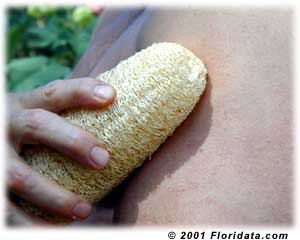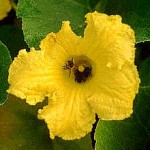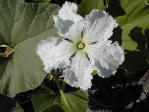San Antonio Express News
GARDENING, Etc.
November 21, 2004
By Lynn Rawe
Gourds are one of Mother Nature’s strangest plant creations, and have been used for thousands of years by many civilizations. Gourds can be used as vessels such as bowls and vases, utensils like dippers or ladles, musical instruments, masks, birdhouses, Thanksgiving table decorations, and Christmas ornaments.
- Cucurbita Gourds
- Cucurbita Flower
- Lagenari gourds used as bird housing
- Lagenaria Flower
There are two genera of gourds, Lagenaria and Cucurbita. Cucurbita are closely related to edible squash and have yellow flowers that turn into small brightly colored fruit. These should be harvested before the first frost. Cucurbita gourds are more difficult to cure and need to be kept in a cool dry place for several weeks to several months. Lagenaria, also known as hard-shelled or calabash gourds, have white flowers and a thick shell. These can have small or quite large fruit, and can withstand a light frost.
Gourds should be harvested when the stem withers and turns brown. Leaving a couple of inches of stem on the gourd adds to the decoration.
Carefully wash the fully matured gourds to remove any debris. Gently rinse the gourds with a disinfectant. You can use one part household bleach and nine parts water or any other type of disinfectant for this step. Place the gourds in a dry area with good circulation, and out of direct sunlight. The gourds should not touch each other. A word to the wise…drying can create an offensive odor, so you want to keep the gourds away from people. Turn the gourds every couple of weeks for even drying. The Lagenaria gourds require a longer drying period to harden fully. The seeds will rattle when the gourd has dried completely.
After the gourds have dried, wash them with soap and water and a soft brush to remove any dust or grime. Rinse with water. Dry at least one hour before painting or staining the gourds.
The Lagenari gourds that are grown for birdhouses can be dried by hanging. Follow the directions listed above except for the drying procedure. Drill a small (1/4 inch) hole in the neck and thread a wire through it as a hanger. A small hole will also need to be drilled in the bottom of the gourd for drainage. After drying, cut a 2 to 2 1/4 inch hole for the birds. Some people may be sensitive to the dust, so wear a mask to avoid exposure.
 Luffa Sponges: The popular Luffa (or Loofah) sponge is made from gourds–(Luffa aegyptica Mill) and is a member of the Cucurbita family. Luffa is closely related to and has similar cultural requirements as the cucumber. On the vine, the Luffa will begin to decrease in weight, and this is a good sign that harvest time is near. Follow the directions above for drying the gourds.
Luffa Sponges: The popular Luffa (or Loofah) sponge is made from gourds–(Luffa aegyptica Mill) and is a member of the Cucurbita family. Luffa is closely related to and has similar cultural requirements as the cucumber. On the vine, the Luffa will begin to decrease in weight, and this is a good sign that harvest time is near. Follow the directions above for drying the gourds.
Once the inside is dry (you can hear the seeds rattle), slice the gourd in half and remove the seeds. Gently peel away the outer skin, leaving the inside fibrous luffa material to be washed and disinfected.
 Luffa sponges in their natural state are a beige-tan color. Soaking in a bleach solution will turn them white. Allow to dry thoroughly on a flat surface. Cut luffa material to desired shape. The luffa can be used alone, or be sewn to a washcloth that has been cut to the same size and shape as the luffa. For more information on luffa sponges, the North Carolina Cooperative Extension has these publications on the web: http://www.ces.ncsu.edu/depts/hort/hil/hil-120.html; http://www.griffin.peachnet.edu/ga/cobb/Horticulture/Plants/Gourds/luffa.htm#background.
Luffa sponges in their natural state are a beige-tan color. Soaking in a bleach solution will turn them white. Allow to dry thoroughly on a flat surface. Cut luffa material to desired shape. The luffa can be used alone, or be sewn to a washcloth that has been cut to the same size and shape as the luffa. For more information on luffa sponges, the North Carolina Cooperative Extension has these publications on the web: http://www.ces.ncsu.edu/depts/hort/hil/hil-120.html; http://www.griffin.peachnet.edu/ga/cobb/Horticulture/Plants/Gourds/luffa.htm#background.
Be creative and find new uses for gourds…and have fun!
This article was written by Lynn Rawe, County Extension Agent-Horticulture with Texas Cooperative Extension in Bexar County.



